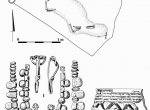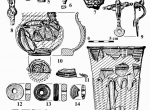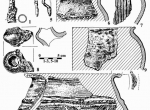Dębczyno
Dębczyno, Białogard district. West Pomeranian Voivodeship (Germ. Denzin, Kr. Belgard), a settlement concentration from the Late Roman Period and early phase of the →Migration Period (phases C1b – E) lying in the drainage basin of the Lower Mogilica and the Middle Parsęta rivers, comprising five settlements (sites 2/A, 3, 6, 6/A, 10), a cemetery (site 2) and another possible mortuary site (site 39). Investigated by H.J. Eggers from Pommersche Landesmuseum Stettin (1937; site 2 - cemetery – 11 graves) and at a later date, more comprehensively (area excavation), by J. Żak and a team from the Adam Mickiewicz University in Poznań (1970-1982; other sites).
Site 2 (cemetery – fig. 1.): 54 burials (52 inhumations, 2 cremations). Grouped in two clusters similar in outlook and chronology. The graves, mostly aligned N/W – S/E, contained dress accessories (brooches, buckles, necklaces of glass and amber beads), pottery vessels and small everyday objects (spindlewhorls, small knives). All the brooches are group AVI, tendril forms or forms with a solid catchplate. The earliest of them are early specimens of AVI, 162, the latest (AVI, 2, F) resemble early forms of brooches with a knob on the bow. The style design of the pottery has affinity with older phase (C1b-C2) ceramics known from the →Dębczyno Group . Chronology of the cemetery: late Roman Period, early →Migration Period (phases C2-C3/D).
Site 2/A (settlement – 360 m2 investigated): identified ca. 30 m from the cemetery. Findings included 2 dugouts, 2 pits, 8 hearths and postholes. Chronology: younger phase of the Roman Period (C2).
Site 3 (settlement – 9430 m2 investigated – fig. 2.): 23 dugouts, 22 posted buildings, 151 hearths, 12 ovens. The settlement was planned around two open spaces (30 x 25 m) designated by dugouts and a hall building. Finds included pottery vessels (hand-built), dress accessories (brooches, buckles, glass and amber beads), tools and weapons (spear- and arrowheads, quernstones, spindlewhorls, small knives, an ard iron), imports (glass vessels and glass beads). The style design of the pottery vessels has affinity with older (C1b-C2) and younger (C3/D-D/E) ceramics known from the →Dębczyno Group . More notable is the inventory of dugout no. 22 (feature 300) dated to mid-5th century, with glass vessels type Snartemo and a squat glass beaker, brooches type Wiesbaden and a brooch with a spade foot. Chronology: early Roman Period to →Migration Period (phase C1b-D/E).
Site 6 (settlement – 4725 m2 investigated – fig. 3.): 32 dugouts, 11 posted buildings, 151 hearths, 12 ovens. The settlement was planned around two open spaces (ca. 30 x 30 m each) designated by dugouts and hall buildings. Some dugouts had various posted constructions. The style design of pottery vessels has affinity with the older (C1b-C2) and the younger (C3/D-D/E) phase in the →Dębczyno Group . Finds included dress accessories (brooches, glass and amber beads), everyday objects (spindlewhorls, small knives, spearheads), imports (glass vessels and beads). One of the youngest built structures in the settlement, a dugout (feature 47) from phase D (older segment of the →Migration Period ), yielded a glass beaker E226, a brooch with a spade foot, glass beads, late vessels corresponding to the younger stage of wares in the →Dębczyno Group . Chronology: early Roman Period to →Migration Period (phases C1b-D/E).
Site 10 (settlement – 3000 m2). Several settlement pits and hearths in an irregular arrangement. Pottery vessels show affinity with the older (C1b-C2) stylistic stage in the →Dębczyno Group . In this site, between the features of Dębczyno Group, were features containing early medieval pottery, type “Dziedzice”. Chronology: younger segment of the Roman Period (phase C2).
Site 39 (possible cemetery – 354 m2). A small number of finds recovered from a multi-phase cemetery (Lusatian, Pomeranian, Oksywie cultures) have been interpreted as the remains of →Dębczyno Group grave inventories (glass beads, pottery vessels). Chronology: younger segment of the Roman Period (phase C2).
The complex at D. is the best investigated in West Pomerania and a valuable source of data on the final stages of the Roman Period and the →Migration Period in the region. Its value is enhanced further by the discovery nearby of hoards type →Karlino and settlements with early medieval pottery, type “Dziedzice”, and by the presence at Białogard site 1 of an earthwork, one of the earliest in West Pomerania, dated to the 7th century.
HM
Literature: H. Machajewski, Z badań nad chronologią dębczyńskiej grupy kulturowej w dorzeczu Parsęty, Poznań 1992; H. Machajewski, Materiały do badań nad obrządkiem pogrzebowym ludności grupy dębczyńskiej, Poznań 1993.
-
 full resolution
full resolution
Fig. 1. Dębczyno, Białogard district, site 2; grave 26 (H. Machajewski 1992).
-
 full resolution
full resolution
Fig. 2. Dębczyno, Białogard district, site 3; feature 300 (H. Machajewski 1992).
-
 full resolution
full resolution
3. Dębczyno, pow Białogard district, site 6; feature 47 (Machajewski 1992).


